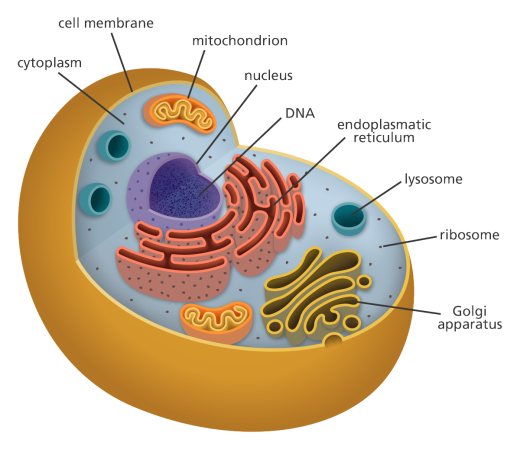- A typical eukaryotic cell is bounded by a plasma membrane.
- Cell wall is present in the case of plant cells,
- The protoplasm is divisible into nucleus and cytoplasm.
- The cytoplasm is in constant motion called cytoplasmic streaming. The streaming movement of cytoplasm around the vacuole is called cyclosis. It contains membrane bounded bodies called organelles, such as mitochondria, plastids, endoplasmic reticulum, ribosomes, Golgi bodies, etc.
- The nucleus is bounded by a porous nuclear membrane allows the exchange of materials between the nucleoplasm and the cytoplasm.

Cell wall
- Cell wall is a rigid and protective protective covering, outer to plasma membrane in plants, bacteria, fungi and some protists.
- It is absent in animal cells.
- It is made up of cellulose in plants, of chitin in fungi and of proteins and non–cellulosic carbohydrates in bacteria.
- Other substances present in the cell wall are pectin, hemicellulose, lignin, suberin, cutin, chitin, fatty acids, minerals such as Ca, Mg etc.
The cell wall is a complex structure composed of the following layers
Primary cell wall:
- It is the first formed cell wall in the immature meristematic and parenchymatous cells.
- It is comparatively thin and permeable.
Secondary cell wall:
- The primary cell wall is followed by thick permeable secondary cell wall.
- It is composed of three concentric layers which occur one after another.
Tertiary cell wall
- In certain plant cells, a thin layer occurs beneath the secondary cell wall is called tertiary cell wall.
- It differs from the primary and secondary cell walls in its morphology, chemistry and staining property.
- It is present in the xylem of gymnosperms.
Middle lamella:
The adjacent cells are cemented together by an intercellular matrix made up of pectin, lignin, calcium pectate and some proteins known as middle lamella.
Plasmodesmata
- The cell walls and the middle lamella of plant cells does not form a continuous layer, but have many pores called pits.
- The protoplasm of the adjacent cells remains connected by means of delicate threads of cytoplasm called plasmodesmata.
- It passes through the pit and maintains the continuity of the cytoplasm.
Functions of cell wall
- It gives strength, rigidity and support to the tissues and organs
- It determines the shape of plant cells.
- It protects the protoplast from turgor pressure developed in it due to intake of more water.
- It maintains the osmotic balance of the cell.
- It helps the aerial parts of the plant body to withstand gravitational forces.
- It helps in the transport of various substances.
- It protects the cell from physical pressures.